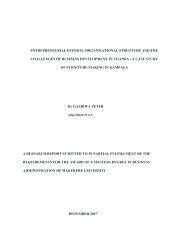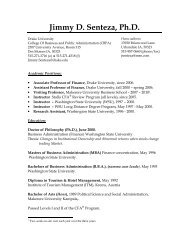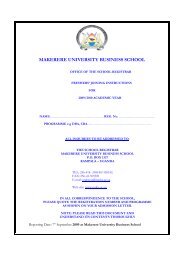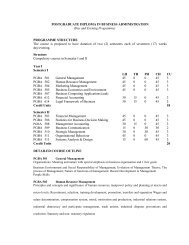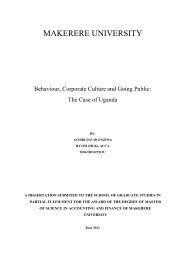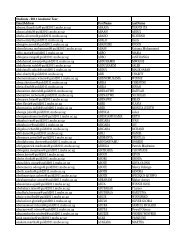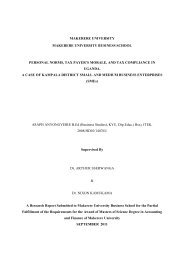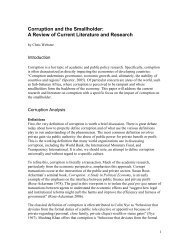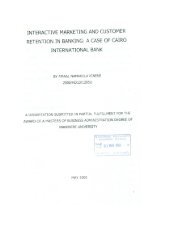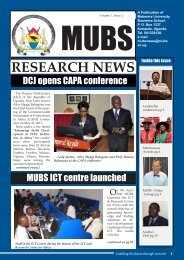13th Annual International Management Conference Proceeding
13th Annual International Management Conference Proceeding
13th Annual International Management Conference Proceeding
Create successful ePaper yourself
Turn your PDF publications into a flip-book with our unique Google optimized e-Paper software.
29. Johnson, J., Daily, C., and Ellstrand, A. (1996); Boards of directors: A review and research agenda. Journal of<br />
<strong>Management</strong> Vol. 22<br />
30. Khurana, R. (1996); Finding the right CEO: Why boards often make poor choices. MIT Sloan <strong>Management</strong><br />
Review, Cambridge, MA: 91-95<br />
31. Kunz, A.H., and Pfaff, D (2002); Agency theory, performance evaluation and the hypothetical construct of intrinsic<br />
motivation. Accounting, organizations and society Vol.27<br />
32. Larson, A. (1992); Network dynads in entrepreneurial settings: A study of the governance of exchange<br />
relationships. Administrative Science Quarterly Vol.37: 76-104<br />
33. March J.G. and J.P. Olsen (1989); Rediscovering Institutions (New York Press)<br />
34. March, J. G, and J. P. Olsen (1984), The New Institutionalism: Organizational factors in political life, American<br />
Political science Review, Vol.78, 738-49<br />
35. March, J. G, and J. P. Olsen (1989); Rediscovering institutions (New York: Free Press).<br />
36. March, J.G. and J.P. Olsen (1984); The New Institutionalism: Organizational factors in political life, American<br />
Political Science review Vol. 78, 738-49 York: Macmillan.<br />
37. Marco Van Herpen, Mirjam Van Praag and Kees Cools (2003), The effects of performance measurement and<br />
compensation on motivation. An empirical study<br />
38. Mathew L. A. Hayward, Violina P. Rindova and Timothy G. Pollock (2004); Believing one’s own press: The<br />
causes and Consequences of CEO Celebrity. Published online in Wiley InterScience<br />
(www.interscience.wiley.com).DOI:10.1002/smj.405<br />
39. MeyerJ, Rowan B. (1977); Institutional Organisations: Formal structure as myth and ceremony. American Journal<br />
Sociology Vol.83: 340-363<br />
40. Nkundabanyanga K.S (2006), Gender diversity on the board of directors, intellectual, and firm performance,<br />
Masters Dissertation; Makerere University<br />
41. Olsen J. P and B.G Peters (1996); Introduction: Learning from experience? In Olsen and Peters, eds., Lessons from<br />
Experience: Experimental Learning from Administrative Reform in Eight Democracies (Oslo: Scandinavian<br />
University Press).<br />
42. Penrose E. T. (1959). The Theory of the Growth of the Firm. New York, NY: John Wiley.<br />
43. Pfeffer J. (1972); Size and composition of corporate boards of director: the organization and its environment.<br />
Administrative Science Quarterly Vol.17: 218-229<br />
44. Pfeffer, J. and Salancik, G. (1978); The external control of organizations: A resource dependence perspective. New<br />
York: Harper Review<br />
45. Scott, W.R. (1995); Institutions and organizations (Thousand Oaks, CA: Sage)<br />
46. Selznick, P. (1949); TVA and the Grass Roots: A Study of the Sociology of Formal Organizations. New York:<br />
Harper & Row.<br />
47. Selznick, P. (1957). Leadership in Administration. New York: Harper and Row.<br />
48. Stigler, G.J. (1964a), Public regulation of the securities markets. The Journal of Business, April pp.112-33<br />
49. Stigler, G.J. (1964b), Comment. The Journal of Business, October, pp. 414-22<br />
50. Sunder, S. (1997). Theory of Accounting and Control. Cincinnati, OH: Southwestern Publishing.<br />
51. Wade M. and Hulland J. (2004); The Resource-based View of information system research: Review, extension and<br />
suggestion, MIS Quarterly review, Vol. 28 No. 1<br />
52. Weisbach, M. (1988). Outside directors and CEO turnover. Journal of Financial Economics, Vol.20: 431-460.<br />
53. Wernerfelt, B. (1984). A resource-based view of the firm. Strategic <strong>Management</strong> Journal, 5: 171-180.<br />
54. Westaphal, J.D and Milton, L.P (2000); How experience and Networks ties affect the influence of demographic<br />
minorities on corporate boards; Administrative Science Quarterly, 45 (1), pp. 366-398<br />
55. Westphal, J.D. (1999); Collaboration in the board room: Behavioral and performance consequences of CEO-board<br />
ties. Academy of <strong>Management</strong> Journal Vol. 42<br />
56. Zahra, S.A and Pearce, J.A. (1989); Boards of Directors and Corporate financial performance: A review and<br />
integrative model. Journal of management, Vol.15<br />
57. Zajac E.J. and Wstphal J.D. (1995); Who shall govern? CEO/board power, demographic similarity, and new<br />
director selection. Administrative science quarterly Vol. 41 60-83<br />
58. Zajac E.J. and Wstphal J.D. (1996); Director reputation, CEO-board power, and the dynamics of board interlocks.<br />
Administrative science quarterly Vol. 41 507-529<br />
59. Zucker.L. (1987) Institutional Theories of Organizations, <strong>Annual</strong> Review of Sociology Vol.13, 443-64<br />
9



